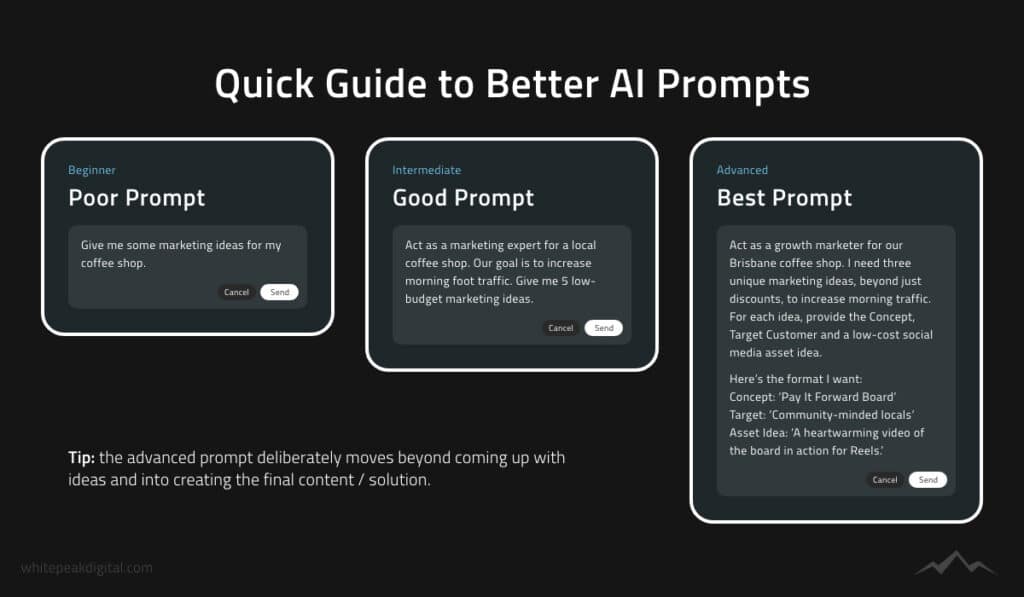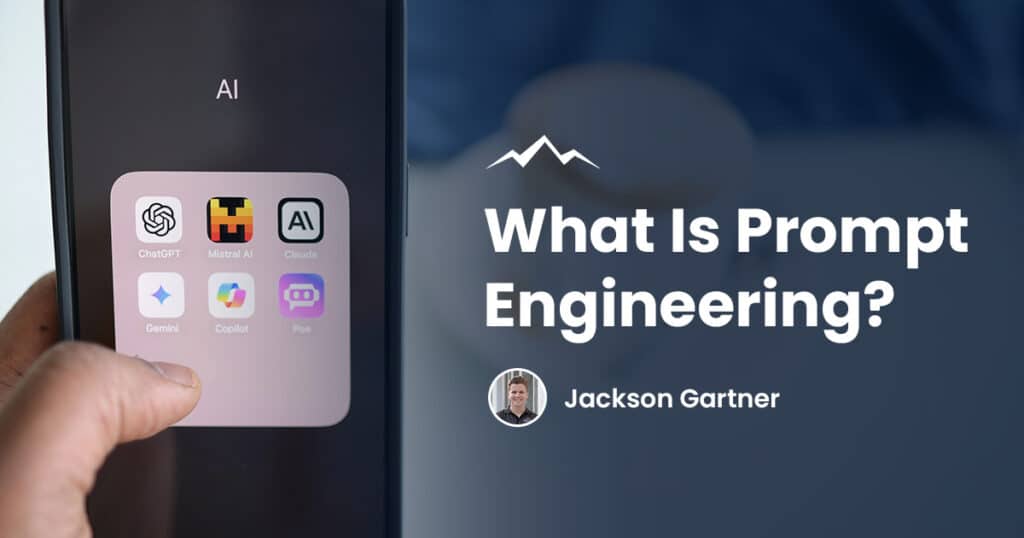The rapid rise of artificial intelligence is impossible to ignore.
Tools like ChatGPT have moved from novelty to necessity in many industries, changing how we approach everything from marketing to data analysis.
But as many users have discovered, the quality of AI-generated output depends heavily on the quality of the input. This is where prompt engineering comes in.
This article provides a deep dive into what is prompt engineering. We will explore why this skill is so important for getting the best out of any AI model.
You will learn the core techniques for writing effective AI prompts and discover the skills needed to master this emerging discipline. Our goal is to equip you with the knowledge to create better prompts from day one.
Mastering this practice will significantly improve your results with generative AI. It enables you to go beyond basic questions and start guiding AI to produce the desired output every time.
For business owners and marketing professionals, this means more accurate, relevant and valuable content, saving you time and boosting productivity.
Tip: Read more about the latest AI impacts on digital marketing on our blog.

Understanding Prompt Engineering
Prompt engineering is the practice of writing effective inputs for AI tools and Large Language Models (LLMs) that will produce optimal outputs.
The goal is simple: to get AI to produce a specific and high-quality response that matches your exact needs and circumstances.
In order to achieve this, you can’t just ask a simple question, you need to provide carefully structured instructions to help the AI model deliver the optimal result.
It’s a relatively new discipline, born directly from the need to interact with highly advanced generative AI models.
As these AIs have become more powerful, our methods for communicating with them have had to evolve too. Effective prompting is the key to unlocking their true potential.
Why Is Prompt Engineering Important
The difference between a generic, unhelpful AI response and an insightful, actionable one often comes down to a single element: the prompt.
Well-crafted prompts are the reason prompt engineering is so important. They directly influence the quality and relevance of the AI generated output.
Strong prompting can accelerate tasks like data analysis, market research and content creation for businesses. When you get the desired output on the first try, you save valuable time and resources.
Furthermore, prompt engineering gives you control over the AI’s tone, style and format. This ensures that any generated content aligns perfectly with your brand’s voice.
It allows the AI system to handle complex tasks with greater accuracy, transforming it from a simple tool into a powerful collaborator that delivers precise and relevant responses.
Core Components Of Effective AI Prompts
An effective prompt is much more than a simple question. It is a comprehensive set of instructions that leaves no room for ambiguity.
To generate desired outputs consistently, you need to provide the AI with everything it needs to understand your request fully.
The best prompts usually contain several key components that work together to guide the AI model. While not every prompt needs every component, understanding these building blocks will dramatically improve your results.
Here are the core elements of a great prompt:
- Context: Provide essential background information so the AI understands the situation.
- Instruction: Clearly state the specific task you want the AI model to complete. This is the direct instruction at the heart of the prompt.
- Persona: Assign a role to the AI, such as “Act as an expert copywriter” or “You are a helpful customer service assistant”.
- Format: Specify the structure of the output you want, such as “Provide the answer in a bulleted list” or “Write a 500-word blog post”.
- Examples: Give the AI tool a few examples to follow. This technique helps it understand your required style and structure.

Direct Instruction & Context
Vague AI prompts and instructions will almost always lead to vague and unhelpful answers.
The difference between asking an AI to “write about our new software” and providing a detailed brief is night and day. A strong prompt gives a clear direct instruction that defines the goal of the task.
Context is just as critical. Providing background information helps the AI system understand the world you are operating in.
For instance, mentioning your target audience, key product features and the overall goal of the content will lead to far more relevant outputs. Remember, even a single word can completely alter the model’s responses.
Defining The AI Persona & Format
Assigning a persona to the AI is a powerful way to fine-tune its response without altering its underlying code or training.
When you ask an AI chatbot to adopt a specific role (like an experienced financial analyst or a witty social media manager) it adjusts its tone, vocabulary and perspective accordingly.
This helps produce content that is perfectly aligned with its intended purpose.
Specifying the output format is equally crucial for achieving your desired outcomes. If you need a comparison of three competitors presented in a table, ask for it directly.
If you require HTML code for a web development project, instruct the AI to provide it. This level of control makes generative AI tools far more practical for real-world tasks.

Key AI Prompt Engineering Techniques
Once you understand the basic components of a good prompt, you can start exploring different prompting techniques.
These methods provide structured approaches for interacting with large language models, helping you tackle everything from simple questions to highly complex tasks.
Different techniques are suited for different goals, so knowing which one to use is a key skill.
We will start with the foundational methods before moving on to more advanced strategies.
Zero Shot vs Few Shot Prompting
Zero shot prompting is the most straightforward technique. It involves giving the AI model a task without providing any prior examples.
This method relies entirely on the model’s vast pre-existing knowledge to generate a response.
It works well for simple requests like “What is the capital of Australia?” or “Summarise this article in three sentences”.
Few shot prompting involves giving the model a few examples of what you want. You provide a small set of typical outputs that demonstrate the desired format or style.
This guides the AI to produce more accurate responses that match your desired format, making it ideal for complex tasks that require a specific structure.
Chain of Thought Prompting
Chain of Thought prompting is a more advanced technique designed to improve an AI’s reasoning ability.
Instead of just asking for the final answer, you instruct the model to “think step-by-step” and explain its reasoning. This encourages the AI to break down a complex task into intermediate steps.
By showing its work, the AI is more likely to arrive at the correct solution. This transparency also allows you to see where the model went wrong if it makes a mistake, making it easier to refine your prompt.
Advanced AI Prompting Strategies
For those who have mastered the basics, advanced strategies can unlock the full power of large language models.
These techniques are used by professionals to push the boundaries of what AI systems can achieve, delivering highly accurate and nuanced results for specialised tasks.
These strategies require more effort to implement but often yield significantly better outcomes, especially when dealing with a complex or niche subject matter.
Generated Knowledge Prompting
Generated knowledge prompting is a clever two-step technique. First, you ask the AI model to generate a list of facts or key information about your topic.
For example, “List the key principles of content marketing for B2B tech companies”.
You then take this generated knowledge and include it in your main prompt. This primes the model with highly relevant information, helping it produce a more comprehensive and accurate final response.
It’s an excellent method for ensuring your output is well-informed and detailed, leading to more accurate responses.
Self Consistency for Accuracy
Self-consistency is a strategy designed to boost the reliability of an AI’s answers, particularly for tasks that require deep reasoning.
It works by running the same prompt multiple times, often using a Chain of Thought approach for each run. You then analyse the various responses and choose the most frequent one as the correct answer.
This method leverages the idea that while an AI might make a random error on one attempt, it is less likely to make the same error repeatedly.
By taking the consensus from several outputs, you significantly improve the chances that the model responds correctly, making it a powerful tool for validation.
Refining Prompts with User Feedback
Effective prompt engineering is not a one-and-done process. It is an iterative cycle of creation, testing and refinement.
The best prompt engineers are constantly refining prompts based on the quality of the AI generated output. Every response from the model is a piece of feedback.
Analysing the output helps you identify weaknesses in your original prompt. Was it too vague? Did it lack sufficient context? This feedback loop is essential for process optimisation.
Incorporating insights from user feedback and model performance is key to mastering the art of the perfect prompt.

Skills For Effective Prompt Engineering
While it may seem technical, prompt engineering is not just for those with a computer science degree.
The most crucial prompt engineering skills are often human-centric, blending analytical thinking with creative communication.
Excelling in this field means developing a unique combination of soft and hard skills.
These abilities allow you to deconstruct problems, communicate intentions clearly and understand the context behind a request.
It is this human element that transforms a basic user into a true prompt engineer.
Critical Thinking & Problem Solving
At its core, prompt engineering is about problem-solving. It requires you to break down a desired outcome into its fundamental components and translate that into instructions an AI can understand.
Critical thinking is essential for diagnosing why a prompt failed and figuring out how to improve it.
This skill is directly linked to process optimisation. A prompt engineer must think strategically about how to get from point A to point B in the most efficient way possible, using the AI as a tool to bridge that gap.
Communication Skills
A deep understanding of language is a superpower in prompt engineering. The ability to use precise wording, understand nuance and structure sentences clearly is vital for crafting effective prompts.
This discipline is a practical application of natural language processing principles from the user’s side.
Clear communication is critical in getting what you want from an AI. You must be able to articulate your needs in a way that the model can interpret without ambiguity, much like giving instructions to a human assistant.
Domain Specific Knowledge
While general prompting skills are useful, domain-specific expertise elevates them to another level.
An expert in marketing, finance or law will know the correct terminology, context and key considerations to include in their prompts. This knowledge is invaluable for generating truly relevant and useful outputs.
For example, a digital marketing professional will craft a far more effective prompt for creating a campaign strategy than a generalist would.
They can guide the AI model with industry-specific insights, leading to more sophisticated and practical results.
Prompt Engineering Use Cases & Jobs
Practical applications for prompt engineering are already widespread and growing every day.
From streamlining business operations to creating entirely new career paths, its impact is undeniable.
Understanding the real-world prompt engineering use cases highlights the value of developing these skills.
Common Use Cases for Prompt Engineering
Businesses across all sectors are leveraging prompt engineering to boost productivity and innovation. Some common applications include:
- Content Creation: Generating high-quality blog posts, social media updates, email newsletters and advertising copy.
- Data Analysis: Summarising complex reports, identifying key trends in data and querying datasets using natural language.
- Software Development: Writing boilerplate code, debugging existing code, translating code between languages and explaining complex algorithms.
- Customer Support: Creating effective chatbot scripts, generating empathetic responses to user queries and summarising customer interactions.
- Market Research: Analysing competitor websites, summarising customer Google reviews and identifying market gaps.

Growth in Prompt Engineering Jobs
Companies are actively hiring for prompt engineering jobs, seeking professionals who can create, manage and optimise prompts for their internal generative AI tools.
These roles are often highly paid and central to a company’s AI strategy.
A prompt engineer is responsible for building and maintaining libraries of effective prompts, training other employees on prompt engineering best practices and working closely with data scientists to get the most out of their AI systems.
This career path is at the forefront of the artificial intelligence revolution and represents a valuable skill set for the future of work.
Mastering effective prompt engineering is an investment in your future efficiency and creativity. The better your prompts, the better your AI agent will be.
Frequently Asked Questions
What is the main goal of prompt engineering?
The main goal is to write precise instructions to guide an AI model to produce the most accurate, relevant and desired output. It’s about optimising the communication between the human user and the generative AI.
Do I need to know programming languages for prompt engineering?
While a background in computer science or programming languages can be helpful, it’s not a strict requirement. Strong skills in logic, creativity and language are more important for creating prompts. However, for advanced applications like integrating with APIs, coding knowledge is beneficial.
How is prompt engineering different from fine tuning an AI model?
Prompt engineering involves refining the input given to an existing model. Fine-tuning is a more complex process that involves retraining parts of the AI model itself on a new dataset to specialise its knowledge.
Can prompt engineering be used to generate images?
Yes, absolutely. The principles of prompt engineering apply to image generation models like Midjourney or DALL-E. Crafting detailed, descriptive prompts is key to guiding these AI tools to generate images that match your vision.
What is one of the most common mistakes in AI prompt engineering?
A common mistake is being too vague. For example, asking an AI to “write about marketing” is far too broad. A good prompt would specify the topic, the tone, the format and the target audience to get optimal responses.
What are some prompt engineering best practices?
Key prompt engineering best practices include being specific and clear, providing context, using personas, giving examples and iterating on your prompts based on the AI model’s responses to continuously improve them.





